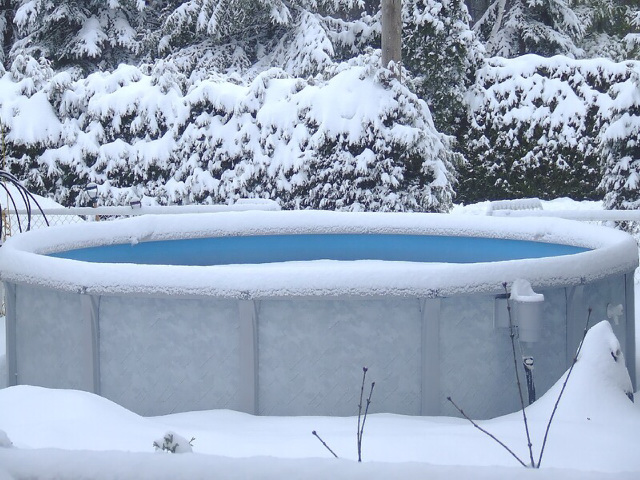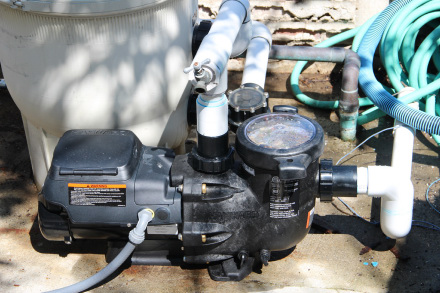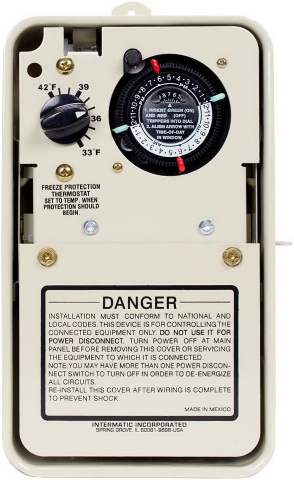Your swimming pool pump works hard, maybe too hard, because you discovered today that the pump has frozen. These things can happen, especially if you haven’t winterized the pump. How do you unfreeze your pool pump quickly?
To unfreeze and thaw a pool pump, you’ll need to disconnect it, take it somewhere warmer and allow the ice to melt. After the ice has melted, you’ll then need to inspect it for damage, like cracking. If all is OK, you can reinstall the pump. You’ll need to inspect the rest of your pool’s system before restarting the pump.
There’s more to it than that so in today’s article, we’ll provide plenty of guidance on thawing a frozen pool pump, expanding further on the steps above. We’ll also discuss how to prevent pump freezing in the future, so make sure you keep reading!

Article Contents
Frozen Bearings or Frozen Water
There are two different ways a pool pump can freeze:
1. The pump’s motor bearings are worn out and frozen or seized up.
2. There is water inside your pump that has frozen preventing it from turning.
Depending on which way your pump has frozen you’ll need to handle it differently. In this article we’ll cover a water frozen pump.
How to Unfreeze (Thaw) a Water Frozen Pool Pump
1. Unplug the Pump
The first order of business is to power it down. Unplug it from its outlet.
If the pump tries to run when it’s still frozen, it can burn out the motor through all the straining. Or if you’re lucky, it will trip the circuit breaker before that happens.
2. Remove the Pump from the Filtration System
If it’s still freezing weather, you’ll need to remove the pump and leave it somewhere warm to thaw out the ice. It’s the most difficult part.
If your filter system plumbing uses unions, then you’ll have to go to each union and untighten the collars. That will allow you to pull out the pump.
It’s more difficult to get the pool pump out if your pool’s filter plumbing system doesn’t use unions. You’ll have to cut through the pipes that surround the pump, using a hacksaw or another tool. Don’t cut right up against the pump, instead leave four inches of pipe sticking out. This makes it easier to replumb the pump.
If you don’t want to cut the pipes to remove the pump in the future, you can always add in two unions to either side.
3. Warm the Pump Until It Thaws
Your pool pump is full of frozen water, and that all has to melt. Leave the pump for a few hours to thaw in a warm place. Make sure you place towels around the pump so it won’t leak water all over your floors.
4. Inspect the Pump for Damage
While you’ve got your pool pump inside, you might as well take the time to give it a thorough inspection. Is the housing damaged in any way? If so, you may be able to repair it with epoxy glue – you won’t know if this has worked until you test the pump for leaks.
Does the shaft freely turn? If it doesn’t the bearings could be seized up. You’ll need to replace the bearings or the pump.
5. Replace the Pump If Necessary
Depending on if your pool pump passed inspection, you might have to replace only the motor bearings or perhaps the whole pump. Admittedly, a new pump is not cheap.
According to HomeAdvisor, the cost of the pump itself can be anywhere from $500 (for a single speed pool pump) to $5,450 (for a high-end variable speed model).
Then you have to get the pool pump reinstalled, which is another $45 to $200 an hour depending on where you live and who you hire for the job.
6. Inspect the Your Filtration System for Damage
A pool that has been frozen and not winterized is bad news. Water expands when it is frozen and this can cause pipes, valves and other components in your filter system damage.
You’ll need to thoroughly check the following parts for cracks and damage:
- Skimmer Box
- Pipes
- Valves / Check Valves
- Unions
- Filter (internal and external inspection)
It’s recommended that you dismantle the valves and filter and inspect them for ice and cracking before switching your system back on.
It’s also possible that you will need to replace the entire filter – they damage easily if frozen.
7. Reinstall & Test the Pump
Reconnect your existing or new pump to the filtration lines. Prime the pump and turn it back on.
You’ll want to check for leaks in the system and check the pressure gauge is normal. If you have high pressure, this could indicate either the filter is blocked or you still could have something that is frozen. Turn off the system immediately and check that nothing is frozen.
If everything is working as intended, then your pump is good to go.

Related Reading: Should You Run Pool Pump When Raining or in a Storm?
How do you prevent your pool pump from freezing again?
The best way to treat a frozen pool pump is to never allow it to freeze in the first place. Sometimes this can be easier said than done, especially if you get busy with work and family life.
Still, after having to shell out several hundred, maybe even several thousand dollars on the pool pump and pipe replacement, this is a costly mistake you don’t want to repeat.
Here’s what we suggest you do to stop a pool pump freezing:
1. Winterize Your Pool Pump to Prevent Freezing
Winterization will always be your best defense against ice damage. To winterize your pool pump, first disconnect it.
Next take the pump lid off. After that you want to undo the drain plugs – there’s usually one under the basket and one where the impeller is (at the bottom). This will drain the water out.
By the way, winterizing your pump is just one of the many steps necessary in preparing your pool for the winter. You should also winterize your water filter, pool heater (if you have one), and the rest of the pool parts.
For a full guide on winterizing your pool, check out our article: How to Winterize Inground Pool
2. Use a Freeze Protection Device
One way to prevent your pump from freezing is to invest in a freeze protection device that connects to the pump.
The device reads the outside air temperature and if the temperature comes close to freezing, then the freeze protection device will turn your pool pump on. This will keep the water moving which can delay freezing.
You can try the Intermatic PF1102T.

This product has a thermostat which you can set the temperature on. This will control the temperature for which the pump is switched on. It also has a timer for if you don’t want to run your pump 24/7.
Click here to check the price >>
Related Reading: Should You Get a Pool Pump Timer? Is it Necessary?
Will Running a Pool Pump Prevent It from Freezing?
Okay, so if you just use your pool pump, it won’t freeze, right?
Yes and no. Keeping the pool pump running can move the water in your swimming pool, which makes it more difficult for the water to freeze. If it gets cold enough though, the water will freeze eventually.
To prevent damage to your pool, when the temperatures are close to freezing, you should winterize your pool and pump. Draining the water out of your pump will prevent damage from freezing.
Does Freezing a Pool Pump Cause Damage?
Your pool pump has been frozen, but you managed to thaw it out. It seems to be working fine now, but you’re still concerned. Will the pump be okay, or should you start setting aside money for a replacement?
It’s hard to say. That’s why we talked about inspecting the pump as part of the thawing process so you can see if your pump survived its big freeze. Most of the time it should be OK but it’s possible the pump housing or lid could have cracked when the water froze and expanded.
Granted, not all damage to the pump is necessarily caused by freezing. If there’s dirt or debris trapped in the motor bearings, then you need to maintain the parts more often. This is also the case if the components of the pump rusted over.
Should I Cover My Pool Pump If It Freezes?
You cover the rest of your swimming pool after the season ends, so why not cover your pool pump as well?
It is a good idea to cover your pump in freezing weather. You’d want to first drain the pump and then put a cover on it. Keep in mind that while covered, don’t run your pump.
Related Reading: Can You Run Your Pool Pump With The Swimming Pool Cover On?
Final Thoughts
A frozen swimming pool pump from a lack of winterization can be a serious problem. You might have to shell out hundreds to thousands of dollars to fix or replace the pump. Please make sure that you flush and drain your pump, then leave it running with the valves open all winter. Best of luck!

